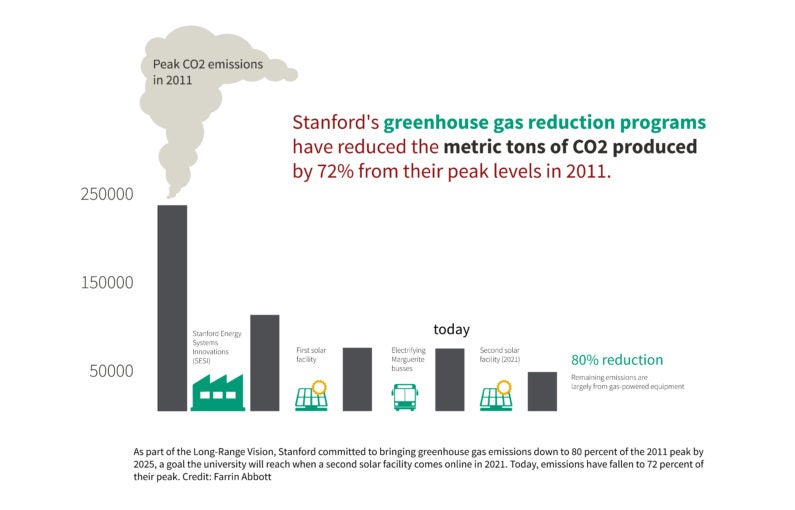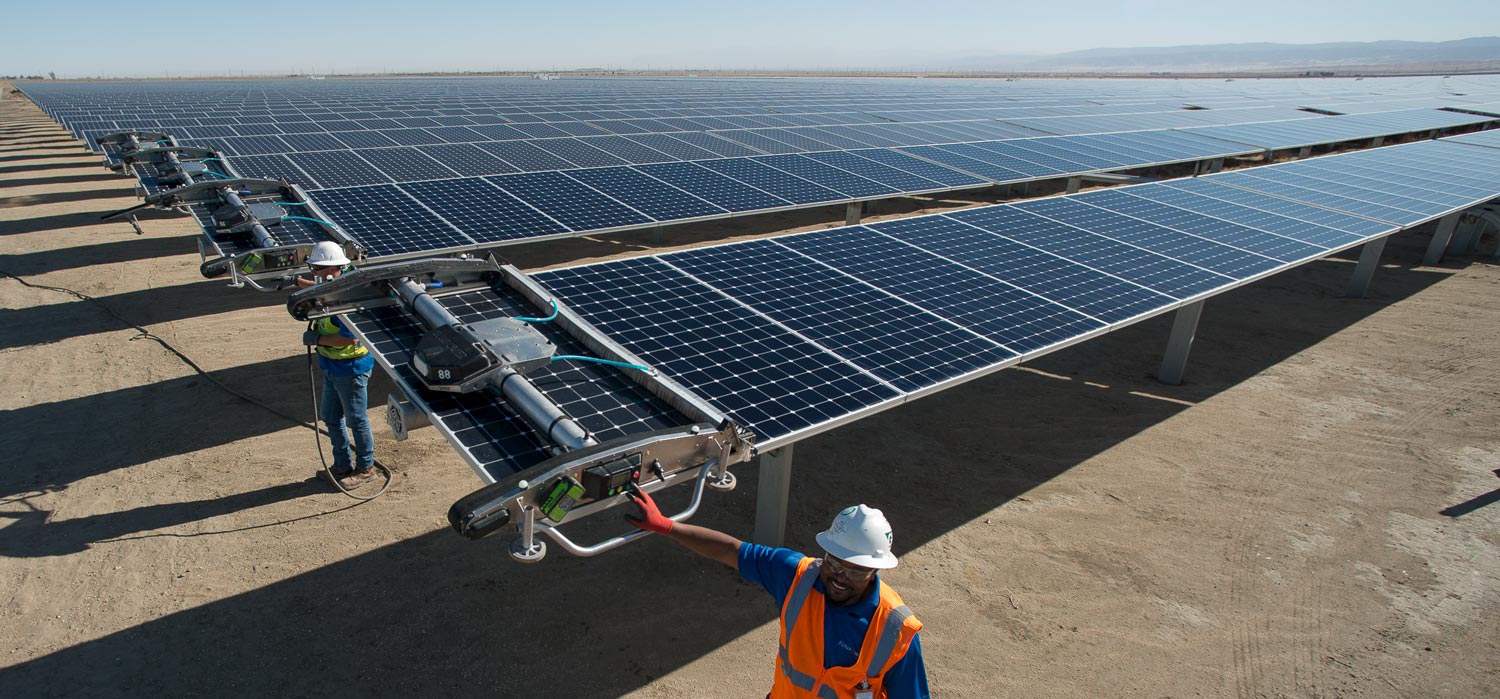Stanford celebrates Earth Day with remote events, commitment to campus sustainability
On April 20, when Stanford kicks off a virtual week-long celebration of the 50th anniversary of Earth Day, the campus will be ahead of schedule to meet sustainability goals and looking ahead to new areas where the university can have an impact.
As the Stanford community prepares to remotely celebrate the 50th anniversary of Earth Day on April 22, campus greenhouse gas emissions have fallen 72 percent below their peak levels in 2011, putting the university ahead of schedule to reach the carbon reduction and sustainability goals laid out by President Marc Tessier-Lavigne as part of the Long-Range Vision.
In his presentation to the Academic Council in May 2019, Tessier-Lavigne called for the university to be using 100 percent renewable energy sources and to have greenhouse gas emissions levels at 80 percent below peak by 2025 – goals Stanford will reach in 2021 when a second 88-megawatt solar generating facility goes online. Tessier-Lavigne also said the university would reach zero waste by 2030 and announced a new campus-wide Sustainability Accelerator.
“The Sustainability Accelerator is an important part of the Long-Range Vision and recognizes the importance of achieving significant reductions in emissions associated with on-campus energy use, not only for meeting the goals the president has laid out, but also as a demonstration of Stanford as a natural lab that others can follow,” said Steve Graham, the dean of Stanford’s School of Earth, Energy & Environmental Sciences (Stanford Earth). “The accelerator encompasses efforts reaching far beyond the campus to develop and scale sustainability solutions that others can implement in their own communities.”
A faculty committee has been exploring academic structures to support the Sustainability Accelerator in achieving its goals of educating students and creating and translating sustainable solutions for the world.
Less energy, fewer emissions
The biggest reduction in Stanford’s greenhouse gas emissions came about after a new energy facility went online in 2015. The Stanford Energy System Innovations (SESI) reduced the energy needed to heat and cool buildings on campus, cutting greenhouse gas emissions 53 percent. Further reductions occurred in 2016 when a 67-megawatt solar generating plant opened in central California. When the second solar facility comes online, Stanford will generate 100 percent of the electricity needed to run the campus from renewable sources.
Beyond SESI and the solar facilities, further emissions reductions have come from upgrading older buildings and constructing new buildings to meet strict energy use guidelines. The university has been exploring ways of reducing the remaining emissions by electrifying gas-powered equipment like fleet vehicles, campus shuttle busses and appliances in laundry facilities and labs.
Stanford’s path for reducing emissions could be a model for how organizations like governments, businesses or other university campuses can reach their own sustainability goals, according to Sally Benson, professor of energy resources engineering in Stanford Earth. She founded the Zero Emission Energy Solutions initiative as part of the Sustainability Accelerator to help partners create their own plans for lowering emissions and to scale those solutions for any organization with ambitious emission reduction goals.
“We have a deep understanding of energy technologies needed to reduce emissions because of the research we’ve done at Stanford, we understand cost and performance and we can help think through the fastest, least expensive pathway for our partners,” said Benson, who is also co-director of the Precourt Institute for Energy. “Our climate modeling research can also help us prepare us for a warmer climate in the future by helping people build resilient energy systems and infrastructure.”

As part of the Long-Range Vision, Stanford committed to bringing greenhouse gas emissions down by 80 percent from the 2011 peak by 2025, a goal the university will reach when a second solar facility comes online in 2021. Today, emissions have fallen by 72 percent of their peak. Click on image to enlarge.
Other carbon sources
All campus greenhouse gas emission reductions to date have been in what is considered Scope 1 and Scope 2 emissions. That means emissions that come directly from creating energy and burning natural gas by campus buildings or vehicles. It does not include what’s known as Scope 3 emissions, which are those that come from producing or shipping products to campus, vehicles driven by the Stanford community, Stanford-related travel or portfolio investments.
The California state emissions goals and those made publicly by large companies all relate to Scope 1 and 2 emissions.
Stanford’s Office of Sustainability has started working with faculty and graduate students to collect data and understand emissions that result from operating the physical campus. These kinds of emissions include business air travel, faculty and staff commutes, and goods and services purchased by the university.
“We are starting to analyze the most nebulous and highest hanging fruits of the carbon mitigation strategies – decarbonizing the supply chain,” said Fahmida Bangert, director of the Office of Sustainability. “In coming years, we will be better able to understand our options for travel, product choices and alternatives for a zero carbon footprint at Stanford.”
Interestingly, one unintended consequence of the group starting their travel-related Scope 3 work this year is that they will capture emissions reductions stemming from faculty, students and staff staying out of cars and airplanes as they shelter in place to slow the spread of COVID-19.

